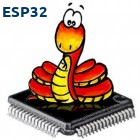-
Notifications
You must be signed in to change notification settings - Fork 345
filesystems
This implementation of MicroPython uses native esp-idf support for file systems and esp-idf VFS.
Two file systems are implemented: internal (Flash file system) and external (SDCard).
The type and size of the Flash file system can be configured before the build using menuconfig
→ MicroPython → File systems.
- The file system can be formated as spiffs or FatFS. FatFS uses esp-idf wear leveling
- Start address in Flash, file system size, maximum number of opened files can be configured
- If using FatFS, Code Page, Long file name support and max long file name length can be configured in
→ Component config → FAT Filesystem supportvia menuconfig.
This setting is also valid for SDCard file system.
Internal file system is mounted automatically at boot in /flash directory and cannot be unmounted.
If the internal file system is not formated, it will be formated automatically on first boot and boot.py file will be created.
SD card can be configured via menuconfig (→ MicroPython → SD Card configuration).
SD card can be connected in SD mode (1-line or 4-line) or in SPI mode.
In SD mode fixed pins must be used.
In SPI mode the pins used for MOSI, MISO, SCK and CS can be selected via menuconfig
Using SDCard in SPI mode is not recommended.
There are known issues when using SDCard in SPI mode and Display module at the same time.
| ESP32 pin | SD name | SD pin | uSD pin | SPI pin | Notes |
|---|---|---|---|---|---|
| GPIO14 (MTMS) | CLK | 5 | 5 | SCK | 10k pullup in SD mode |
| GPIO15 (MTDO) | CMD | 2 | 3 | MOSI | 10k pullup, both in SD and SPI modes |
| GPIO2 | D0 | 7 | 7 | MISO | 10k pullup in SD mode, pull low to go into download mode |
| GPIO4 | D1 | 8 | 8 | N/C | not used in 1-line SD mode; 10k pullup in 4-line SD mode |
| GPIO12 (MTDI) | D2 | 9 | 1 | N/C | not used in 1-line SD mode; 10k pullup in 4-line SD mode |
| GPIO13 (MTCK) | D3 | 1 | 2 | CS | not used in 1-line SD mode, but card's D3 pin must have a 10k pullup |
| N/C | CD | optional, not used | |||
| N/C | WP | optional, not used | |||
| VDD 3.3V | VSS | 4 | 4 | ||
| GND GND | GND | 3&6 | 6 |
SDcard pinout / uSDcard pinout (Contacts view):

SD card must be formated before it can be used in MicroPython. At the moment there is no option to format SD card from MicroPython.
External file system can be mounted/unmounted using the following functions from uos module:
| Method | Notes |
|---|---|
uos.mountsd([chdir]) |
Initialize SD card and mount file system on /sd directory. If optional argument chdir is set to True, directory is changed to /sd after successful mount |
uos.umountsd() |
Unmount SD card. Directory is changed to /flash after successful unmount |
Prepared image file can be flashed to ESP32, if not flashed, filesystem will be formated after first boot.
SFPIFFS image can be prepared on host and flashed to ESP32:
Copy the files to be included on spiffs into components/spiffs_image/image/ directory. Subdirectories can also be added.
Execute:
./BUILD.sh makefs
to create spiffs image in build directory without flashing to ESP32
Execute:
./BUILD.sh flashfs
to create spiffs image in build directory and flash it to ESP32
Execute:
./BUILD.sh copyfs
to flash the default spiffs image components/spiffs_image/spiffs_image.img to ESP32
Prepared image file can be flashed to ESP32, if not flashed, filesystem will be formated after first boot.
FatFS image can be prepared on host and flashed to ESP32:
Copy the files to be included on spiffs into components/fatfs_image/image/ directory. Subdirectories can also be added.
Execute:
./BUILD.sh makefatfs
to create FatFS image in build directory without flashing to ESP32
Execute:
./BUILD.sh flashfatfs
to create FatFS image in build directory and flash it to ESP32
Execute:
./BUILD.sh copyfatfs
to flash the default FatFS image components/fatfs_image/fatfs_image.img to ESP32
